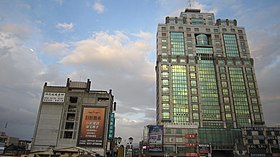Miaoli
|
Miaoli 苗栗市 |
||
 Station buildings in Miaoli |
||
|
||
| State : |
|
|
| County : | Miaoli | |
| Coordinates : | 24 ° 34 ' N , 120 ° 49' E | |
| Height : | 50 - 240 m | |
| Area : | 37.8878 km² | |
| Residents : | 88,340 (Sep 2018) | |
| Population density : | 2,332 inhabitants per km² | |
| Time zone : | UTC + 8 (Chungyuan time) | |
| Telephone code : | (+886) (0) 37 | |
| Postal code : | 360 | |
| ISO 3166-2 : | TW-MIA | |
| Community type : | city | |
| Structure : | 28 districts ( 里 , Lǐ ) | |
| Mayor : | Qiu Bingkun (邱炳坤) (independent) | |
| Website : | ||
|
|
||
Miaoli ( Chinese 苗栗市 , Pinyin Miáolì Shì ) is a city with almost 90,000 inhabitants in the Republic of China on Taiwan . It is the capital of Miaoli County .
location
Miaoli is the political, economic and cultural center of the district of the same name. The city is located in the northwestern part of Taiwan in the valley of Houlong -Flusses, the east and north flows past the city center and around 10 km north-west in the Taiwan Strait opens. The western part of the urban area is occupied by hills that reach heights of about 240 m. Due to the numerous mountains in the area, Miaoli is also known as the "mountain town".
The city has a connection to Highway 1, Taiwan's most important north-south artery, and a conventional railway station. The route of the Taiwan High Speed Rail touches the city area without stopping.
The 3789 hectare urban area comprises around 1800 hectares of mountain land and 900 hectares of agricultural land in the east.
history
The area of the city of Miaoli was originally settled by Taokas , an indigenous people of Taiwan . In their language, Miaoli means "plane".
From 1737 the region was settled by immigrants from mainland China, mostly Hakka from Guangdong Province . To this day, the Hakka make up a large proportion of the population of Miaoli, and the city is one of their centers in Taiwan.
During the Japanese rule of Taiwan , Miaoli was the capital of a district in Shinchiku Prefecture . Under the Republic of China, the city became the seat of the district of Miaoli and initially had the status of a township ( 鎮 , Zhèn ). On December 25, 1981, it was promoted to City ( 市 , Shì ).
The United National University (NNU), founded in 2003, is located in Miaoli .
population
The proportion of the Hakka population in Miaoli was estimated at almost 90% in 2016 based on a sample survey. The categorization as "Hakka" is complex, however, and many people indicate in surveys that they feel they belong to more than one identity (e.g. also as a Hoklo ). In contrast, the proportion of indigenous peoples in Miaoli was low. At the end of 2017, 780 people (approx. 0.9%) were counted here.
City administration
Miaoli is divided into 28 districts ( 里 , Lǐ ) (the numbering given below has no official character).
1. Lümiao ( 綠 苗 里 )
2. Yumiao ( 玉 苗 里 )
3. Xinmiao ( 新苗 里 )
4. Qingmiao ( 青苗 里 )
5. Zhongmiao ( 中 苗 里 )
6. Shangmiao ( 上 苗 里 )
7. Gaomiao ( 高 苗 里 )
8. Beimiao ( 北 苗 里 )
9. Huaqingli ( 華 清 里 )
10. Yuqingli ( 玉清 里 )
11. Yuhua ( 玉華 里 )
12. Weixiang ( 維 祥 里 )
13. Weixin ( 維新 里 )
14. Fu'an ( 福安 里 )
15. Fuxing ( 福星 里 )
16. Jiangong ( 建功 里 )
17. Jiaxin ( 嘉 新 里 )
18. Jiasheng ( 嘉盛 里 )
19. Datong ( 大同 里 )
20. Gongjing ( 恭敬 里 )
21. Shengli ( 勝利 里 )
22. Shuiyuan ( 水源 里 )
23. Nanshi ( 南 勢 里 )
24. Xinying ( 新 英里 )
25. Xinchuan ( 新 川 里 )
26. Fuli ( 福麗 里 )
27. Wenshan ( 文山 里 )
28. Wensheng ( 文 聖 里 )
Twin cities
Miaoli has various partnership agreements with other cities. However, the contacts with the three US locations are not very active. In contrast, the exchange with the Japanese partner community is quite intensive.
-
 Lake St. Louis (Missouri), USA (1989)
Lake St. Louis (Missouri), USA (1989) -
 Wentzville (Missouri), USA (1989)
Wentzville (Missouri), USA (1989) -
 Kissimmee (Florida), USA (1989)
Kissimmee (Florida), USA (1989) -
 Shimizu ( Shizuoka Prefecture ), Japan (2003)
Shimizu ( Shizuoka Prefecture ), Japan (2003)
Web links
Individual evidence
- ↑ 地理 環境 ("Geographic Area"). City website, accessed November 27, 2018 (Chinese).
- ↑ 105 年度 全國 客家 人口 暨 語言 基礎 資料 調查 研究 (“National Basic Data Survey of the Hakka Population and Language 2016”). (pdf) Hakka Affairs Council at the Executive Yuan, accessed November 27, 2018 (Chinese).
- ↑ 原住民 戶數 及 人數 Households and Persons of Indigenous People. (xls) Taiwan Ministry of the Interior, accessed May 19, 2018 (Chinese / English).
- ^ City Exchange. English language website of the city, accessed on November 27, 2018 (English).




